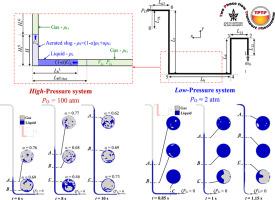Modeling of high-pressure transient gas-liquid flow in M-shaped jumpers of subsea gas production systems
IF 3.6
2区 工程技术
Q1 MECHANICS
International Journal of Multiphase Flow
Pub Date : 2024-09-21
DOI:10.1016/j.ijmultiphaseflow.2024.105003
引用次数: 0
Abstract
Two-phase flow with low liquid loads is common in high-pressure natural gas offshore gathering and transmission pipelines. During gas production slowdowns or shutdowns, an accumulation of liquid in the lower sections of subsea pipelines may occur. This phenomenon is observed in jumpers that connect different units in deep-water subsea gas production facilities. The displacement of the accumulated liquid during production ramp-up induces temporal variations in pressure drop across the jumper and forces on its elbows, resulting in flow-induced vibrations (FIV) that pose potential risks to the structural integrity of the jumper. To bridge the gap between laboratory experiments and field conditions, transient 3D numerical simulations were conducted using the OpenFOAM software. These simulations facilitated the development of a mechanistic model to elucidate the factors contributing to increased pressure and forces during the liquid purging process. The study examined the influence of gas pressure level, pipe diameter, initially accumulated liquid amount, liquid properties, and gas mass flow rate on the transient pressure drop and the forces acting on the jumper's elbows. The critical gas production rate required for complete liquid removal of the accumulated liquid was determined, and scaling rules were proposed to predict the effects of gas pressure and pipe diameter on this critical value. The dominant frequencies of pressure and force fluctuations were identified, with low-pressure systems exhibiting frequencies associated with two-phase flow phenomena and high-pressure systems showing frequencies attributed to acoustic waves.

海底天然气生产系统 M 型跃层中的高压瞬态气液流动建模
高压天然气海上集输管道中常见的是低液体负荷的两相流动。在天然气生产放缓或关闭期间,海底管道下部可能会出现液体积聚。这种现象在深水海底天然气生产设施中连接不同装置的跳线上也能观察到。在生产提升过程中,积聚液体的位移会导致跨接器上的压降和弯头上的力发生时间变化,从而产生流动诱发振动(FIV),对跨接器的结构完整性构成潜在风险。为了缩小实验室实验与现场条件之间的差距,我们使用 OpenFOAM 软件进行了瞬态三维数值模拟。这些模拟有助于建立一个机理模型,以阐明液体吹扫过程中导致压力和力增加的因素。研究考察了气体压力水平、管道直径、初始累积液体量、液体特性和气体质量流量对瞬态压降和作用在跨接器弯头上的力的影响。确定了完全清除积聚液体所需的临界气体生产率,并提出了比例规则,以预测气体压力和管道直径对该临界值的影响。确定了压力和力波动的主要频率,低压系统显示出与两相流现象相关的频率,高压系统显示出声波频率。
本文章由计算机程序翻译,如有差异,请以英文原文为准。
求助全文
约1分钟内获得全文
求助全文
来源期刊
CiteScore
7.30
自引率
10.50%
发文量
244
审稿时长
4 months
期刊介绍:
The International Journal of Multiphase Flow publishes analytical, numerical and experimental articles of lasting interest. The scope of the journal includes all aspects of mass, momentum and energy exchange phenomena among different phases such as occur in disperse flows, gas–liquid and liquid–liquid flows, flows in porous media, boiling, granular flows and others.
The journal publishes full papers, brief communications and conference announcements.

 求助内容:
求助内容: 应助结果提醒方式:
应助结果提醒方式:


